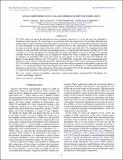BULK COMPOSITION OF GJ 1214b AND OTHER SUB-NEPTUNE EXOPLANETS
Author(s)
Valencia, Diana; Guillot, Tristan; Parmentier, Vivien; Freedman, Richard S.
DownloadValencia-2013-Bulk composition of.pdf (856.8Kb)
PUBLISHER_POLICY
Publisher Policy
Article is made available in accordance with the publisher's policy and may be subject to US copyright law. Please refer to the publisher's site for terms of use.
Terms of use
Metadata
Show full item recordAbstract
GJ 1214b stands out among the detected low-mass exoplanets, because it is, so far, the only one amenable to transmission spectroscopy. Up to date there is no consensus about the composition of its envelope although most studies suggest a high molecular weight atmosphere. In particular, it is unclear if hydrogen and helium are present or if the atmosphere is water dominated. Here, we present results on the composition of the envelope obtained by using an internal structure and evolutionary model to fit the mass and radius data. By examining all possible mixtures of water and H/He, with the corresponding opacities, we find that the bulk amount of H/He of GJ 1214b is at most 7% by mass. In general, we find the radius of warm sub-Neptunes to be most sensitive to the amount of H/He. We note that all (Kepler-11b,c,d,f, Kepler-18b, Kepler-20b, 55Cnc-e, Kepler-36c, and Kepler-68b) but two (Kepler-11e and Kepler-30b) of the discovered low-mass planets so far have less than 10% H/He. In fact, Kepler-11e and Kepler-30b have 10%-18% and 5%-15% bulk H/He. Conversely, little can be determined about the H[subscript 2]O or rocky content of sub-Neptune planets. We find that although a 100% water composition fits the data for GJ 1214b, based on formation constraints the presence of heavier refractory material on this planet is expected, and hence, so is a component lighter than water required. The same is true for Kepler-11f. A robust determination by transmission spectroscopy of the composition of the upper atmosphere of GJ 1214b will help determine the extent of compositional segregation between the atmosphere and the envelope.
Date issued
2013-08Department
Massachusetts Institute of Technology. Department of Earth, Atmospheric, and Planetary SciencesJournal
The Astrophysical Journal
Publisher
IOP Publishing
Citation
Valencia, Diana, Tristan Guillot, Vivien Parmentier, and Richard S. Freedman. “BULK COMPOSITION OF GJ 1214b AND OTHER SUB-NEPTUNE EXOPLANETS.” The Astrophysical Journal 775, no. 1 (August 29, 2013): 10. © 2013 The American Astronomical Society
Version: Final published version
ISSN
0004-637X
1538-4357